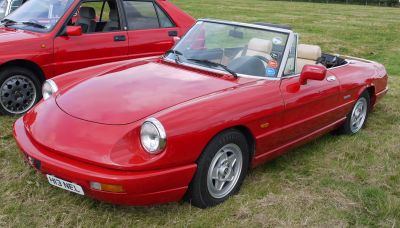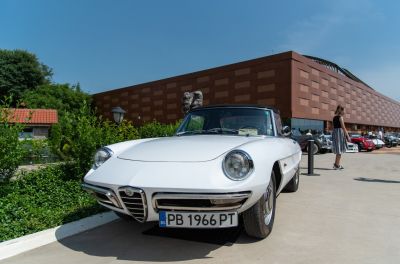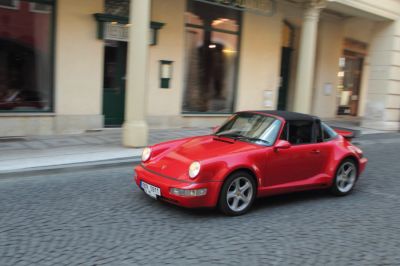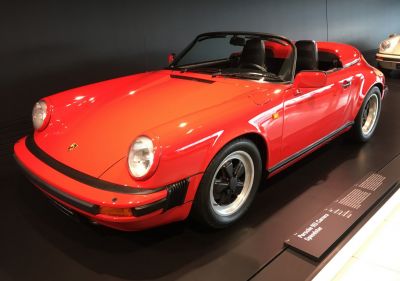 1990 Porsche 911 Cabriolet (964) Dimensions, Size & Specs
1990 Porsche 911 Cabriolet (964) Dimensions, Size & SpecsMeasurements of the 1990 Porsche 911 Cabriolet, engineered for optimal performance and comfort
| Dimensions | |
|---|---|
| Length: | 4250 mm167.3 in13.9 ft |
| Width: | 1650 mm65.0 in5.4 ft |
| Height: | 1310 mm51.6 in4.3 ft |
| Trunk Capacity: | 90 liter3.2 cu ft |
| Tire Specifications | |
| Rims Sizes: | 16-inch rims:
|
| Tire Sizes: |
|
The Porsche 911 Cabriolet (964), produced from 1989 to 1994, is a distinguished model in the iconic 911 lineage, combining classic design with practical cabriolet functionality. Measuring 4250 mm (167.3 inches) in length, 1650 mm (64.96 inches) in width, and standing 1310 mm (51.57 inches) tall, the 964 Cabriolet offers a compact yet sporty profile, perfect for enthusiasts seeking an open-air driving experience without compromising on agility and performance. The streamlined body design maintains the signature Porsche 911 look admired worldwide, emphasizing both aesthetics and aerodynamics.
Underneath its elegant exterior, this 1990 generation features a luggage capacity of 90 liters (approx. 3.18 cubic feet), which is modest yet sufficient for weekend trips or daily use. The model rides on 16-inch rims with varying widths: 7J on the front and 9J on the rear, fitted with 205/55 R16 front tires and wider 225/50 R16 rear tires. This setup enhances traction and cornering capabilities, essential traits for the spirited driving Porsche is known for.
In summary, the 1990 Porsche 911 Cabriolet (964) blends classic design with well-balanced dimensions that offer both style and functional use. Its compact footprint combined with the available tire and rim sizes ensures a dynamic and enjoyable drive whether cruising city streets or enjoying open highways.
Discover the standout features that make the 1990 Porsche 911 Cabriolet a leader in its class
Have a question? Please check our knowledgebase first.
The Porsche 911 Cabriolet (964), produced between 1989 and 1994, measures 4250 mm (approximately 167.3 inches) in length, 1650 mm (about 65 inches) in width, and stands 1310 mm (roughly 51.6 inches) tall. These dimensions contribute to its classic and compact sports car silhouette, offering a balanced combination of agility and road presence typical of early 1990s sports cars.
The luggage capacity of the Porsche 911 Cabriolet (964) is quite limited, with only 90 liters (approximately 3.2 cubic feet) available. This small space reflects the car's sports car focus, where emphasis is placed on performance and style rather than cargo capacity. It is suitable for small bags or groceries, but it might be challenging for longer trips requiring more luggage, making it more ideal for weekend drives or city use.
The Porsche 911 Cabriolet (964) comes equipped with wheels sized at 7J x 16 and 9J x 16, paired with tires sized 205/55 R16 on the front and 225/50 R16 on the rear. These tire dimensions and wheel sizes help provide the car with excellent grip and handling characteristics, important for maintaining the 911's sporty driving dynamics and balanced road performance.
With a width of 1650 mm (about 65 inches), the Porsche 911 Cabriolet (964) is relatively narrow compared to many modern vehicles. Standard garage widths typically range from about 2400 mm to 3000 mm (approximately 8 to 10 feet), so the 911 Cabriolet fits comfortably within most standard garages with plenty of side clearance. This compact width is advantageous for urban parking and garage storage.
Standing at 1310 mm (51.6 inches) tall, the 964 Cabriolet has a low roofline consistent with traditional sports cars of its era. This height contributes to a lower center of gravity, enhancing handling and stability. While the sleek height maximizes aerodynamic efficiency and sporty aesthetics, it may limit headroom slightly compared to taller vehicles. The cabriolet design, however, allows open-air driving, which compensates for any perceived interior space constraints.
At 4250 mm (167.3 inches), the Porsche 911 Cabriolet (964) is moderately sized relative to other early 1990s sports cars. It is longer than many compact sports cars but remains agile and easy to maneuver. This length provides a good balance between interior space for two occupants and maintaining the signature rear-engine layout characteristic of the 911, which influences handling and driving dynamics.
Compared to its predecessor, the 911 Cabriolet from the G-Series (produced until 1989), the 964 model introduced a more modern and refined design with slightly updated proportions. The 964 Cabriolet's length of 4250 mm and width of 1650 mm tend to be very similar or marginally larger, improving stability and interior comfort. The height remains low to maintain aerodynamics and sporty styling. Overall, the 964 generation offered incremental dimensional improvements for better performance and aesthetics.
The Porsche 911 Cabriolet (964) competes closely dimensionally with other sports car cabriolets from its era, such as the Jaguar XJ-S Convertible and BMW Z3 Roadster. While slightly longer than some compact competitors, the 911 remains narrower and lower, emphasizing a distinctive performance-oriented design. Its compact width and low height improve maneuverability and aerodynamic efficiency, while matching the practicality of other two-seater convertibles in terms of luggage space and road presence.
Yes, the Porsche 911 Cabriolet (964) is quite suitable for urban parking due to its compact width of 1650 mm (65 inches) and moderate length of 4250 mm (167 inches). Its narrow width allows easier fitting into tight parking spaces and narrow city streets, while its length is manageable for typical urban garages and parking lots. This makes the 964 Cabriolet a practical choice for daily drivers or enthusiasts who need a sports car that is agile in urban environments.
The Porsche 911 Cabriolet (964) represents an important evolution in the 911 lineage, featuring advanced technical improvements such as updated suspension, improved aerodynamics, and modern safety features compared to earlier models. Produced from 1989 to 1994, it retained the classic 911 rear-engine layout but offered more refined driving dynamics and comfort, marking a transition toward modernity while preserving the timeless sports car character. It remains a beloved classic for enthusiasts due to its blend of heritage and innovation.
Discover similar sized cars.

| Production: | 1966-1993 |
|---|---|
| Model Year: | 1970 |
| Length: | 4260 mm167.7 in |
| Width: | 1630 mm64.2 in |
| Height: | 1290 mm50.8 in |

| Production: | 1966-1977 |
|---|---|
| Model Year: | 1966 |
| Length: | 4250 mm167.3 in |
| Width: | 1630 mm64.2 in |
| Height: | 1290 mm50.8 in |

| Production: | 1989-1993 |
|---|---|
| Model Year: | 1990 |
| Length: | 4250 mm167.3 in |
| Width: | 1652 mm65.0 in |
| Height: | 1310 mm51.6 in |

| Production: | 1989 |
|---|---|
| Model Year: | 1989 |
| Length: | 4250 mm167.3 in |
| Width: | 1652 mm65.0 in |
| Height: | 1280 mm50.4 in |
